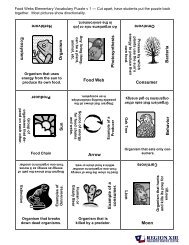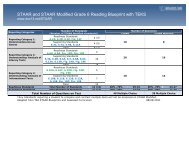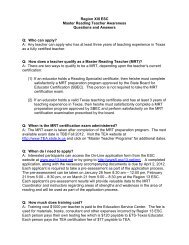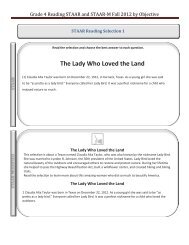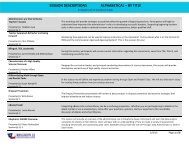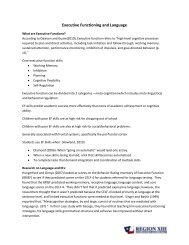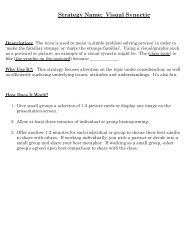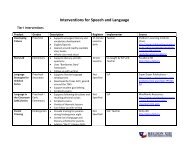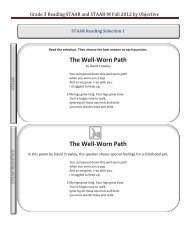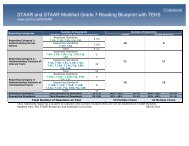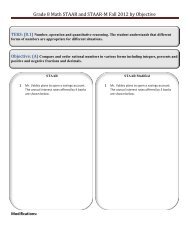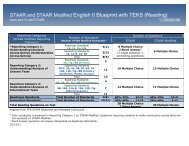2nd Six Weeks Newsletter - Region 13
2nd Six Weeks Newsletter - Region 13
2nd Six Weeks Newsletter - Region 13
You also want an ePaper? Increase the reach of your titles
YUMPU automatically turns print PDFs into web optimized ePapers that Google loves.
2010—2011 Second <strong>Six</strong> <strong>Weeks</strong> PreviewEnglish Language Artsthroughout the unit to support comprehension of oral and written expression. Word study is inclusive of genre specificvocabulary, literary terms, and appropriate vocabulary from the literature. In Grade 8, students analyze literary works thatshare similar themes across cultures, explain how values and beliefs of particular characters are affected by the historicaland cultural setting, analyze linear plot development to determine conflict resolution, analyze how the central characters’qualities influence the theme and resolution of the conflict, and analyze more complex forms of point of view.8 th GradeUnit 2: Analyzing Nonfiction and Poetry. In Grades 6 and 7, students identified literary language and techniques,structural patterns, and features of nonfiction narrative texts and wrote personal narratives that effectively conveyed theirown experiences. During this unit, students continue to analyze literary nonfiction texts and poetry along with passagesfrom well-known speeches focusing on the author’s use of literary devices/techniques and word and phrase choice. Theycontinue to write personal narratives and poetry by applying more complex literary skills. The study of vocabulary, spelling,punctuation, capitalization, and grammar throughout the unit supports comprehension and oral and written communication.Word study is inclusive of genre specific vocabulary, literary terms, and appropriate vocabulary from the literature.In Grade 9, students analyze how literary essays interweave personal examples and ideas with factual informationalong with the effects of diction and imagery in poetry. They continue to write a variety of literary texts including stories,poems, and scripts with increasing complexity.English IUnit 2A: Continuing the Journey through Poetry. In Grade 7 and Grade 8, students identified graphical elements andcompared and contrasted purposes and characteristics of a variety of poetic forms. During this unit, students use skillsacquired in analysis of fiction to support their understanding and analysis of the effects of literary techniques (e.g., diction,imagery) in poetry. They write poetry utilizing effective structural elements and figurative language. Students listenresponsively and give effective presentations using appropriate conventions for purpose and audience. Using writing forthe comparison of themes across fictional literature and poetry fosters reading and writing connections and allows fordevelopment of more complex reading interpretation strategies. Word study is inclusive of genre specific vocabulary,literary terms, and appropriate vocabulary from the literature. The emphasis of writing conventions and vocabulary providea foundation for continued reflection on communicative accuracy. In English II, students identify and analyze theeffects of structure and graphic elements used in poetry.Unit 2B: Moving Forward with Drama. In Grade 8, students analyzed how playwrights characterized their protagonistand antagonist through the use of dialogue and staging. During this unit, dramatic forms (conventions) including monologue,soliloquy, and dramatic irony are identified and explained for their effect on text. Students write a script with aclear theme using techniques that communicate an understandable mood and tone. Using writing for the comparison ofthemes across fictional literature, poetry, and drama fosters reading and writing connections and allows for developmentof more complex reading interpretation strategies. Word study is inclusive of genre specific vocabulary, literary terms,and appropriate vocabulary from the literature. The emphasis of writing conventions and vocabulary provide a foundationfor continual reflection on communicative accuracy. In English II, students analyze the role of elements (e.g., archetypes)and structure (e.g., motifs) in plot development.English IIUnit 2A: Analyzing Poetic Structure. In English I, students understood and analyzed the effects of literary techniquesin poetry such as diction and imagery. They wrote poems including ballads and sonnets using structural elements andfigurative language. During this unit, students identify and analyze the purpose of structure in prosody (e.g., meter,rhyme scheme) and graphic element structures (e.g., line length, punctuation, word position) used in poetry and explainthe effects of literary techniques studied in Unit 1. Using writing for the comparison of themes across fictional literatureand poetry fosters reading and writing connections and allows for development of more complex reading interpretationstrategies. Word study is inclusive of genre and literary vocabulary, appropriate academic vocabulary, and vocabularyfrom the literature. The emphasis of writing conventions and word meaning provide a foundation for continual reflectionon communicative accuracy and clarity. In English III, students explore American poetry by analyzing the effects of metricsand rhyme schemes.Unit 2B: Deeper Analysis through Drama. In English I, students examined dramatic forms (conventions) includingmonologue, soliloquy, and dramatic irony and identified and explained their effects on text meaning. During this unit, studentscontinue to analyze specific elements (e.g., archetypes) and techniques (e.g., motifs) in a variety of literary works9



